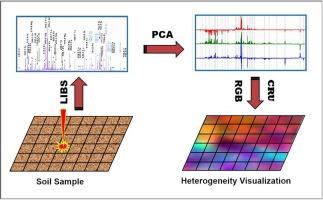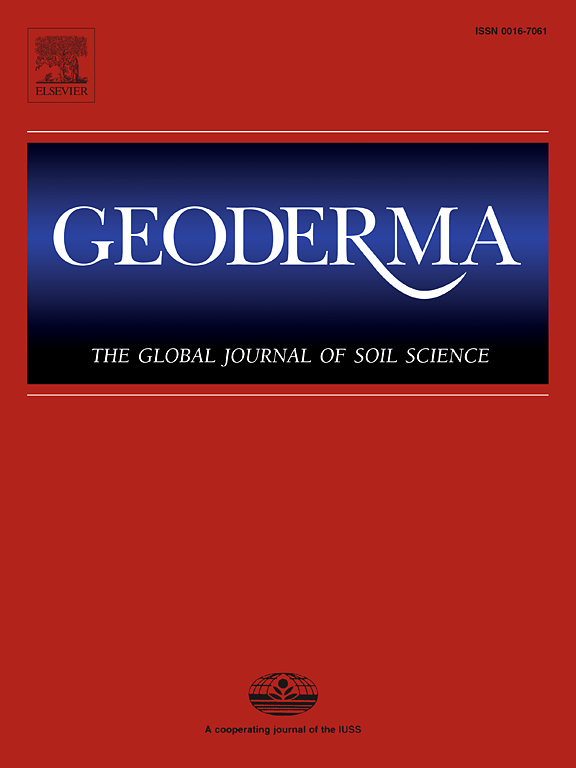通过激光诱导击穿光谱测定控释尿素在中尺度上改变了稻田土壤的异质性
IF 5.6
1区 农林科学
Q1 SOIL SCIENCE
引用次数: 0
摘要
由于作物轮作和肥料投入,农田土壤表现出很强的异质性,对土壤异质性的表征将有助于理解土壤管理。本研究采用激光诱导击穿光谱(LIBS)技术,在中尺度(20 μm ∼ 2 mm)上对长期施用控释氮的水稻田土壤异质性进行了原位研究。LIBS 光谱的主成分分析(PCA)解释了前三个 PC 中的元素分布。PC1 包含较多的 K、O、Al、Si、Na、Ca 和 Mg 信息(超过 50%),PC2 包含较多的 Li、Ti、Fe、K、Mg 和 Si 信息(40%),PC3 包含较多的 Ca、Mg、Mo、Ti 和 Pb 信息(35-40%)。以 PC1、PC2 和 PC3 作为色标,构建了红-绿-蓝复合图。通过中尺度颜色混合图对土壤异质性进行了原位可视化,分层聚类分析显示,控制释放氮输入量的增加改变了土壤异质性。因此,LIBS 提供了一种在中尺度上实现土壤异质性数字描述的方法,可作为获取土壤时空信息的另一种选择,用于评估农业管理对土壤质量的影响。本文章由计算机程序翻译,如有差异,请以英文原文为准。

Controlled release urea altered the paddy soil heterogeneity at mesoscale qualified by laser induced breakdown spectroscopy
Farmland soil shows strong heterogeneity due to crop rotations and fertilizer inputs, and characterization of soil heterogeneity will benefit understanding soil management. In this study, the technique of laser induced breakdown spectroscopy (LIBS) was used to investigate the heterogeneity of paddy soil in-situ at mesoscale (20 μm ∼ 2 mm) under long term input of controlled release nitrogen. Principal component analysis (PCA) of LIBS spectra interpreted elements distribution in the first three PCs. PC1 contained higher proportions of K, O, Al, Si, Na, Ca and Mg information (more than 50 %), PC2 contained more proportions of Li, Ti, Fe, K, Mg and Si information (40 %), and PC3 contained more proportions of Ca, Mg, Mo, Ti and Pb information (35–40 %). The Red-Green-Blue composite using PC1, PC2 and PC3 as color codes was constructed. Soil heterogeneity was in-situ visualized by color blending maps at mesoscale and the hierarchical cluster analysis showed that increasing input of controlled released nitrogen altered soil heterogeneity. Therefore, LIBS provided a method to achieve a digital description of soil heterogeneity at mesoscale, which could be an alternative option to capture spatio-temporal soil information for evaluating the effects of agricultural management on soil quality.
求助全文
通过发布文献求助,成功后即可免费获取论文全文。
去求助
来源期刊

Geoderma
农林科学-土壤科学
CiteScore
11.80
自引率
6.60%
发文量
597
审稿时长
58 days
期刊介绍:
Geoderma - the global journal of soil science - welcomes authors, readers and soil research from all parts of the world, encourages worldwide soil studies, and embraces all aspects of soil science and its associated pedagogy. The journal particularly welcomes interdisciplinary work focusing on dynamic soil processes and functions across space and time.
 求助内容:
求助内容: 应助结果提醒方式:
应助结果提醒方式:


